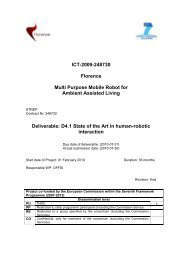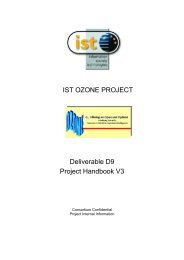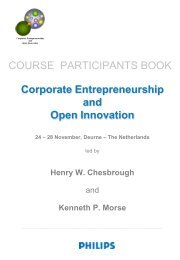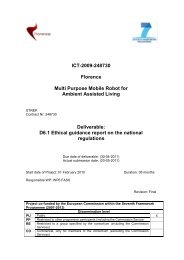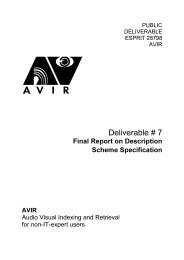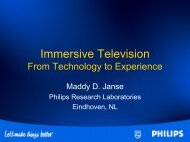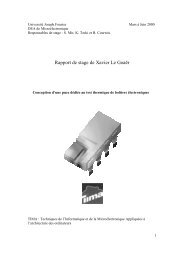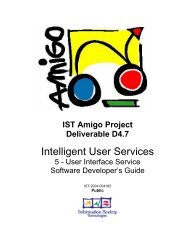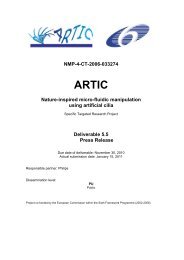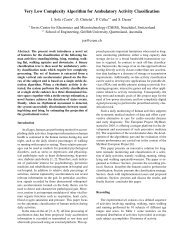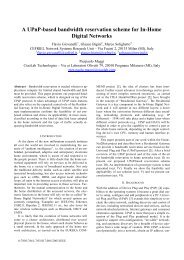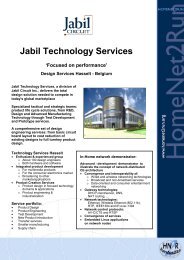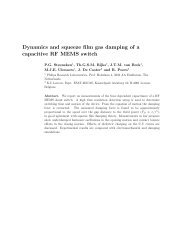Leaflet of the WASP project - Hitech Projects
Leaflet of the WASP project - Hitech Projects
Leaflet of the WASP project - Hitech Projects
Create successful ePaper yourself
Turn your PDF publications into a flip-book with our unique Google optimized e-Paper software.
Ambient Intelligence: Ubiquitous sensing<br />
to improve our lives at home and on<br />
<strong>the</strong> move<br />
Introduction<br />
The infrastructure for ambient intelligence<br />
envisaged by researchers and industry in<br />
Europe, will consist <strong>of</strong> a myriad <strong>of</strong> wireless<br />
sensors working in collaboration.<br />
The academic world is currently hard at work<br />
investigating <strong>the</strong> technology for Wireless<br />
Sensor Networks (WSN). However, industry<br />
is reluctant to use <strong>the</strong> results derived from<br />
academic research, principally because <strong>the</strong>re is<br />
a mismatch between research at <strong>the</strong> application<br />
level and <strong>the</strong> node and network level.<br />
<strong>WASP</strong><br />
Wirelessly Accessible Sensor Populations<br />
S<strong>of</strong>tware technology, Moving objects, Wireless Sensor Networks,<br />
Energy-optimization, Security, Quality <strong>of</strong> Service guarantees,<br />
Cross-layer optimization, SME involvement.<br />
The <strong>WASP</strong> <strong>project</strong> aims to rectify this<br />
imbalance by covering every link in <strong>the</strong> chain,<br />
from basic hardware, sensors, processors and<br />
communication, right through to <strong>the</strong> packaging<br />
and organization <strong>of</strong> <strong>the</strong> nodes, <strong>the</strong> information<br />
distribution, and a selection <strong>of</strong> applications.The<br />
main emphasis in <strong>the</strong> <strong>project</strong> lies in <strong>the</strong> selforganization<br />
and <strong>the</strong> services which connect <strong>the</strong><br />
application to <strong>the</strong> sensor network.The nodes<br />
<strong>the</strong>mselves also need research because <strong>the</strong>re is a<br />
strong link between <strong>the</strong> flexibility required and<br />
<strong>the</strong> hardware design.The applications need to be<br />
researched, because <strong>the</strong> properties <strong>of</strong> <strong>the</strong> services<br />
required will influence <strong>the</strong> configuration <strong>of</strong><br />
both sensor network and application for optimum<br />
efficiency and functionality. Many <strong>of</strong> <strong>the</strong><br />
design decisions inherent to <strong>the</strong> development<br />
cannot be handled in isolation as <strong>the</strong>y depend on<br />
<strong>the</strong> hardware costs involved in making a sensor<br />
and <strong>the</strong> market size for sensors <strong>of</strong> a given type.<br />
The general goal <strong>of</strong> <strong>the</strong> <strong>project</strong> is <strong>the</strong> provision<br />
<strong>of</strong> a complete system view for building large<br />
populations <strong>of</strong> collaborating objects.<br />
The provision <strong>of</strong> a European alternative to <strong>the</strong><br />
WSNs originating in <strong>the</strong> US will have a positive<br />
impact on European research and industry.<br />
The <strong>WASP</strong> results will be well suited for<br />
adoption by SMEs.The consortium will define<br />
an active programme to approach <strong>the</strong><br />
appropriate SMEs and to familiarize <strong>the</strong>m<br />
with <strong>the</strong> <strong>WASP</strong> results.<br />
General <strong>project</strong> overview:<br />
<strong>WASP</strong><br />
Contract number:<br />
IST-034963<br />
Full name:<br />
Wirelessly Accessible<br />
Sensor Populations<br />
Type <strong>of</strong> <strong>project</strong>:<br />
Integrated Project<br />
Project participants:<br />
• Philips Research<br />
Eindhoven<br />
(The Ne<strong>the</strong>rlands)<br />
• CEFRIEL (Italy)<br />
• IMEC-NL<br />
(The Ne<strong>the</strong>rlands)<br />
• CSEM (Switzerland)<br />
• TU Eindhoven<br />
(The Ne<strong>the</strong>rlands)<br />
• European Micros<strong>of</strong>t<br />
Innovation Center<br />
(Germany)<br />
• Health Telematic<br />
Network (Italy)<br />
• Fraunh<strong>of</strong>er-Gesellschaft<br />
(Germany)<br />
• ASG veehouderij<br />
(The Ne<strong>the</strong>rlands)<br />
• Imperial College<br />
(United Kingdom)<br />
• ST microelectronics<br />
(Italy)<br />
• INRIA (France)<br />
• EPFL (Switzerland)<br />
• Philips Research<br />
Aachen (Germany)<br />
• Centro Ricerche Fiat<br />
(Italy)<br />
• TU Kaiserslautern<br />
(Germany)<br />
• RWTH Aachen<br />
(Germany)<br />
• SAP (France)<br />
• University <strong>of</strong><br />
Paderborn (Germany)<br />
Contact person:<br />
First name: Peter<br />
Last name: van der Stok<br />
Enterprise:<br />
Philips Research<br />
Address:<br />
High Tech Campus 31<br />
5656 AE Eindhoven<br />
The Ne<strong>the</strong>rlands<br />
Tel: +31 40 2742649<br />
Fax: +31 40 2744004<br />
E-mail: peter.van.der.stok<br />
@philips.com<br />
Project website:<br />
www.wasp-<strong>project</strong>.org/
Assisted road transport lowers <strong>the</strong> risk <strong>of</strong> accidents,<br />
reduces pollution and fuel consumption and<br />
improves <strong>the</strong> flow <strong>of</strong> traffic on our roads.<br />
Three business areas, selected for <strong>the</strong>ir societal<br />
relevance and technical differences, will validate<br />
<strong>the</strong> results <strong>of</strong> <strong>the</strong> <strong>project</strong>.<br />
Care <strong>of</strong> <strong>the</strong> elderly will benefit from reduced<br />
medical costs and increased quality <strong>of</strong> life <strong>of</strong> <strong>the</strong><br />
elderly.<br />
Objectives<br />
The aims <strong>of</strong> <strong>the</strong> <strong>WASP</strong> <strong>project</strong> are:<br />
The development <strong>of</strong> an autonomous and<br />
intelligent infrastructure, which incorporates<br />
a wireless sensor network.<br />
The development <strong>of</strong> a cost-efficient infrastructure<br />
that encourages application driven<br />
optimisation <strong>of</strong> <strong>the</strong> network composed <strong>of</strong><br />
generic nodes.<br />
The deployment <strong>of</strong> <strong>the</strong> infrastructure developed<br />
within a prototype, to validate both <strong>the</strong><br />
sensor network design and <strong>the</strong> genericity <strong>of</strong><br />
<strong>of</strong>fered design.<br />
<strong>WASP</strong><br />
EU<strong>Projects</strong><br />
Herd health control reduces <strong>the</strong> risk <strong>of</strong> diseases,<br />
which pose a threat to <strong>the</strong> European livestock<br />
industry.<br />
Expected Results<br />
A consistent chain <strong>of</strong> s<strong>of</strong>tware components<br />
to support (dynamic) energy optimization,<br />
security, Quality <strong>of</strong> Service guarantees, and <strong>the</strong><br />
specification <strong>of</strong> trade-<strong>of</strong>f preferences by <strong>the</strong><br />
application.<br />
Sets <strong>of</strong> cross-layer optimized s<strong>of</strong>tware stacks<br />
with each set optimized for a given set <strong>of</strong><br />
application characteristics.<br />
A set <strong>of</strong> benchmarks and measurements to<br />
compare energy efficiency and code efficiency<br />
between existing s<strong>of</strong>tware and new alternatives.<br />
Design rules for <strong>the</strong> configurable sensor nodes,<br />
and <strong>the</strong>ir applications and optimization<br />
strategies.<br />
A prototype implementation in two <strong>of</strong> <strong>the</strong><br />
three chosen business areas.<br />
http://www.wasp-<strong>project</strong>.org/<br />
Partners and <strong>the</strong>ir roles<br />
• Philips Research Eindhoven:<br />
Integration and consistency<br />
• CEFRIEL: Communication models<br />
• IMEC-NL:Adaptable node<br />
• CSEM:Wireless routing and optimization<br />
• TU Eindhoven: Computational and<br />
service models<br />
• European Micros<strong>of</strong>t Innovation Center:<br />
Development environment<br />
• Health Telematic Network: Home care<br />
providers<br />
• Fraunh<strong>of</strong>er-Gesellschaft: Sensor adaptation<br />
• ASG Veehouderij: Herd control application<br />
• Imperial College: Chronic disease and<br />
elderly care<br />
• ST Microelectronics: Low power design<br />
• INRIA:Algorithms and flexible s<strong>of</strong>tware<br />
environment<br />
• EPFL: Large network for validation<br />
• Philips Research Aachen:WSN security,<br />
elderly care<br />
• Centro Ricerche Fiat: Road transport<br />
application<br />
• TU Kaiserslautern:Timeliness <strong>of</strong> WSN and<br />
applications<br />
• RWTH Aachen: Data transport over network<br />
• SAP: Secure business access to WSN<br />
• University <strong>of</strong> Paderborn: Coordination <strong>of</strong><br />
execution environment & protocol<br />
optimization.<br />
This <strong>project</strong> is part <strong>of</strong> <strong>the</strong> portfolio <strong>of</strong> <strong>the</strong><br />
Embedded Systems Unit – G3<br />
Directorate General Information Society<br />
For more information please check:<br />
http://cordis.europa.eu/ist/embedded<br />
January 2007



